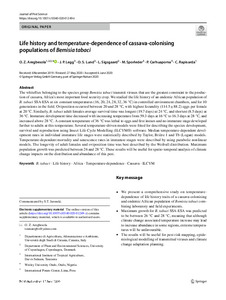| dc.contributor.author | Aregbesola, O.Z. |
| dc.contributor.author | Legg, J.P. |
| dc.contributor.author | Lund, O.S. |
| dc.contributor.author | Sigsgaard, L. |
| dc.contributor.author | Sporleder, M. |
| dc.contributor.author | Carhuapoma, P. |
| dc.contributor.author | Rapisarda, C. |
| dc.date.accessioned | 2022-08-22T07:54:56Z |
| dc.date.available | 2022-08-22T07:54:56Z |
| dc.date.issued | 2020-06-17 |
| dc.identifier.citation | Aregbesola, O.Z., Legg, J.P., Lund, O.S., Sigsgaard, L., Sporleder, M., Carhuapoma, P. & Rapisarda, C. (2020). Life history and temperature-dependence of cassava-colonising populations of Bemisia tabaci. Journal of Pest Science, 93, 1225-1241. |
| dc.identifier.issn | 1612-4758 |
| dc.identifier.uri | https://hdl.handle.net/20.500.12478/7670 |
| dc.description.abstract | The whiteflies belonging to the species group Bemisia tabaci transmit viruses that are the greatest constraint to the production of cassava, Africa’s most important food security crop. We studied the life history of an endemic African population of B. tabaci SSA-ESA at six constant temperatures (16, 20, 24, 28, 32, 36 °C) in controlled environment chambers, and for 10 generations in the field. Oviposition occurred between 20 and 28 °C, with highest fecundity (114.5 ± 88.2) eggs per female at 20 °C. Similarly, B. tabaci adult females average survival time was longest (19.7 days) at 24 °C, and shortest (8.5 days) at 36 °C. Immature development time decreased with increasing temperature from 59.3 days at 16 °C to 16.3 days at 28 °C, and increased above 28 °C. A constant temperature of 36 °C was lethal to eggs and first instars and no immature stage developed further to adults at this temperature. Several temperature-driven models were fitted for describing the species development, survival and reproduction using Insect Life Cycle Modelling (ILCYM®) software. Median temperature-dependent development rates in individual immature life stages were statistically described by Taylor, Brière 1 and Tb (Logan) models. Temperature-dependent mortality and senescence rates in immature stages were described by using parabolic nonlinear models. The longevity of adult females and oviposition time was best described by the Weibull distribution. Maximum population growth was predicted between 26 and 28 °C. These results will be useful for spatio-temporal analysis of climate change impacts on the distribution and abundance of this pest. |
| dc.description.sponsorship | Education, Audiovisual and Culture Executive Agency of the European Commission |
| dc.format.extent | 1225-1241 |
| dc.language.iso | en |
| dc.subject | Bemisia Tabaci |
| dc.subject | Life Cycle |
| dc.subject | Temperature |
| dc.subject | Africa |
| dc.subject | Cassava |
| dc.subject | Pest Insects |
| dc.title | Life history and temperature-dependence of cassava-colonising populations of Bemisia tabaci |
| dc.type | Journal Article |
| cg.contributor.crp | Roots, Tubers and Bananas |
| cg.contributor.affiliation | Università degli Studi di Catania |
| cg.contributor.affiliation | University of Copenhagen |
| cg.contributor.affiliation | International Institute of Tropical Agriculture |
| cg.contributor.affiliation | International Potato Center |
| cg.coverage.region | Africa |
| cg.coverage.region | East Africa |
| cg.coverage.country | Tanzania |
| cg.coverage.hub | Central Africa Hub |
| cg.researchtheme | Plant Production and Health |
| cg.identifier.bibtexciteid | AREGBESOLA:2020 |
| cg.isijournal | ISI Journal |
| cg.authorship.types | CGIAR and advanced research institute |
| cg.iitasubject | Agronomy |
| cg.iitasubject | Cassava |
| cg.iitasubject | Pests of Plants |
| cg.iitasubject | Plant Breeding |
| cg.iitasubject | Plant Health |
| cg.iitasubject | Plant Production |
| cg.journal | Journal of Pest Science |
| cg.notes | Published online: 17 June 2020 |
| cg.accessibilitystatus | Limited Access |
| cg.reviewstatus | Peer Review |
| cg.usagerightslicense | Copyrighted; all rights reserved |
| cg.targetaudience | Scientists |
| cg.identifier.doi | https://dx.doi.org/10.1007/s10340-020-01249-z |
| cg.iitaauthor.identifier | Oluwatosin Zacheous Aregbesola: 0000-0003-3971-0344 |
| cg.iitaauthor.identifier | James Legg: 0000-0003-4140-3757 |
| cg.futureupdate.required | No |
| cg.identifier.volume | 93 |

